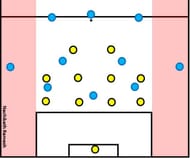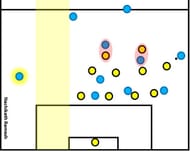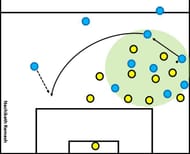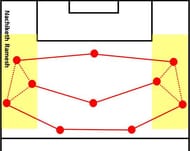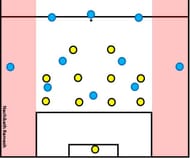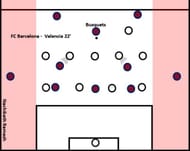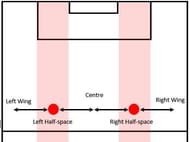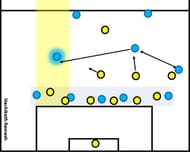PEP TALK is a new series on SportsKeeda. Click here to read PEP TALK 01 – First Impression.
It has been nearly a month since Pep Guardiola took charge at Manchester City. The players are slowly getting accustomed to the methods of Guardiola. Having come from different academies, where they played in systems very dissimilar to Guardiola’ style, it is going to be a tough time for the players to attain the required technical skills, tactical understanding and develop synergies amongst themselves.
With 9 days left for the new season to start, and with one friendly game before that against Arsenal, City’s new manager will be keen to see how well the players have taken to his playing system.
Against Dortmund in China, City had some issues in coping with the opponents in high-pressing. City’s shape while high-pressing BVB was porous and let the opposition permeate through the middle and get into dangerous positions.
The back-line of three center backs had problems in dealing with Dortmund’s narrow wingers. If the center backs were staying narrow and tracking the wingers to the midfield, then they were opening space behind the near-side wingback. Dortmund’s wingbacks were overlapping the wingers to create scoring chances.
While these are the loopholes that Guardiola needs to fix in the coming days and get his squad ready to play the way he wants, there is an even bigger challenge fronting him. As he walks through the isthmus that is the transitional phase from Bundesliga and it’s pressing style to Premier League - physically dominant and deep defending teams - Guardiola is bound to experience new things. On such thing is, he might find himself playing against teams that are more than willing to sit back and defend.
Low block – A brief introduction
Low block is a defensive mechanism, adopted by almost all teams at some point in the game, wherein the team without the ball defends deep and close to its own 18-yard box. Some teams defend with a low block or deep defensive line purposefully – knowing that bottle-necking the passage into the box is one of the methods to prevent the opposition from scoring. Some teams, on the other hand, move deep as the opponents come closer and closer towards the goal and adopt it only during certain scenarios of the game.
In the past, we have witnessed teams defending deep in order to deny space near the goal for the teams that dominate possession. The best examples are that of Inter Milan against Barcelona in the second leg of Champions League semi-final 2009-10 and, Chelsea against Barcelona in the first leg at the same stage of Champions League.
In both matches, Inter Milan and Chelsea stifled the Catalan team’s attacking prowess by staying extremely compact and having very less ball possession. Staying compact to deny space is one of the main characteristics of the teams that defend deep.
Teams that defend deep mostly try to be passive in nature and look to pose attacking threats mainly by counter-attacking. The image attached above shows a deep defending team with both horizontal and vertical compactness. Some teams are not as horizontally compact as the one shown above. Teams also use the wingers or wide midfielders to cover the width while defending very deep.
How can Guardiola beat low defensive blocks? An analysis
Defending with a low block is considered by many coaches as the only way to win against teams that play the possession style. While it is possible to press aggressively and constantly or counter-press or play narrow or play vertically, many still stick to the technique used by Jose Mourinho’s Inter Milan. But is it possible to beat a low block defence? Yes. If so, how?
By providing width and stretching the compact defences
The main aim should be to cover the entire width of the field, which Guardiola’s teams regularly do, so as to spread out the attack from the left to the right. This affects the way the opponents position themselves. The teams that defend deep usually try to cover the central zones or have a compact shape. Such teams have ball-oriented movements. As the ball shifts from the central regions to the wings, the team also shifts – in the process, closing down space and passing options of the player on the ball.
This forces the attacking teams to circulate the ball from one wing to another, in “U” shape, without any penetration. But consider the situation when the ball is in the center – the wings are generally unoccupied by the defending team.
It could so happen that the defending team might not want to compromise with the horizontal compactness while moving the wide midfielder towards the ball. Such situations can leave open the half-space and wing on the far side. Accessing this half-space will be tough for the attacking team. However, the wing can be easily occupied, since it takes time for the team to shift, through a switch ball.
If the defending team is stretched and horizontal compactness is lost, then not just the space on the far side wings, but also space in the central region can be freed up. This can be accessed through a combination play triggered by a switch pass.
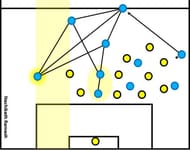
Here's a video of Atletico Madrid under Diego Simeone doing the same against Chelsea.
Overloads to unlock space on the far side
Another possible way of opening gaps in low defensive blocks is by concentrating the play on one particular region of the field – usually the wing or the half-space. This involves the attacking team focusing on combinational play in a narrow space and thus inviting the deep defending to press and win the ball. Since the defending team concentrates on blocking the ball progression through the space, it leaves open space on the far side.
This space can be attacked by the free player through a switch ball or a direct diagonal ball. Overloading and focusing one side and finishing the attacking move through the other side has been one of the key aspects of Guardiola’s teams.
City players were seen practicing this in one of the training sessions. It could be for beating teams that defend deep by surprising them by attacking the under loaded side of the field. Here’s a video.
Gaps in the defensive block and combinational play
If the defending team tries to block the passing options on a wing by using only a minimal number of players and maintains the presence in the wing or half-space on the far side, then inadvertently, gaps will be opened in the defensive block. Such gaps prove to be the difference between losing and winning a game.
Guardiola likes players who are good at decision making and ball control in tight spaces and the center. Such players will obviously take advantage of the free space and some extra time on the ball and assert their dominance over the opponents close to them.
Pass combinations can be tried during such situations, to drag the defenders out of position. If by chance excess space is available in front of the defensive line, then even through balls and shots can be fired from just outside the box.
Using triple width to create space in the center:
Triple width is provided when three players of different lines of the formation occupy the wide zones. It is mostly used by teams that focus on the wings while attacking. By providing triple width, that is by moving the central midfielder and winger closer towards the wing, the defenders close to them can be forced to follow them. Following the defending team will focus on narrowing down to deny ball progression between the three attacking players on the wings.
Using three wide lines or players of three different lines on the wings, wing-focus can be achieved. Thus deep defending opposition can be moved towards the zone where the attacking team wants them to be and not where the defending team is comfortable. By pulling them move over to the wings, the central zones, half-spaces and wide zones can be opened and attacked.
Proper depth in wide regions for complete usage of width
Two wide players and the ball in the center means the defending team will shift if the ball is passed more towards the horizontal axis, as said before. But if the ball is passed more towards the vertical axis, then the dominance in wide regions can be taken advantage of. In order for this to happen, the player on the wing should be positioned such that he is in a deeper position or at least in line with the midfield line of the defending team. If so, the pass made will not only be moving to a zone where the defending team has no presence but it is also inclined more towards the vertical axis.
In one action, the attacking team is achieving two things – reaching width and gaining depth. So the defending team has to shift over to the side. They have to do so by keeping up with the ball’s vertical motion as well. This means the wide player of the attacking team will get a chance to either put the ball into the space behind the defensive line through a cross or put the ball in the space in front of the defensive line. The outcome depends on the how the defending team reacts to such an attacking pass.
In the image attached below, we can see how the wingbacks of Barcelona positioned wide and deep. This gives the player on the ball, Sergio Busquets, the options of passing wide towards the right-back, Dani Alves. In the game, as a precaution, Valencia’s wide players on the left adjusted their body position so as to reach out to the player on the wing in case Busquets passed to him. But the Barcelona player actually passed the ball through the center to one of the central midfielders.
So, wide and deep positioning not only helps in gaining access to wide zones closer to the goal but also in feinting the deep defending team into giving up their control over the central regions.
Specific focus on positioning players in half-spaces in the attacking half of the field
The positioning of players matters a lot when it comes to attacking and breaking down compact defences with low blocks. In all the previous methods of unlocking spaces in a low block, I have maintained one thing – positioning in the wings. But since it is easy to get pressed and force the ball backward, the wings offer much less positional superiority compared to the central regions.
In the center, if a player positions in the half-spaces, that is the narrow vertical strip between the center and the wings, then access to both the center and the wings can be easily achieved.
As Maric explains, positioning in half-space can lead to distortions in opposition’s defensive shape. Body orientation, the positioning and movement of the defenders can be influenced by a player who has ball possession in half-space. If the ball is in the wings, the defending team closes down the passage. If the ball is in the middle, the defending team becomes compact with respect to the ball. But if it is in the half-space, then switching becomes easy. This causes problems for the defending team.
Here’s a video, where I have tried to explain the advantages of positioning in the half-spaces.
Moreover, it can allow ball progression through the middle.
Bayern 3-3-4. 2 wide players. 2 in half-space. Alonso pivot. Muller drops to provide an extra option for Boateng. pic.twitter.com/2EbhOA0GZN
— Nachiketh Ramesh (@NachikethRamesh) July 13, 2016
Instead of high wing focus – of course, the wing focus can help in space opening – if teams focus on half-spaces, then commanding the game becomes a lot easier. The aim finally is to move the defenders where we want them to move. Here’s a video showing how Thiago’s positioning helped Atletico Madrid in breaking Chelsea’s tight defense.
Overloading the defensive line
By overloading the defensive line, the attacking team can pin down at least four defenders at the back. When Guardiola’s Bayern Munich used a 2-3-2-3 or W-W formation against CSKA Moscow’s deep 5-4-1, Munich’s forward line was changing to a 5-man chain. This was pinning nearly six CSKA defenders close to the box and space was being created in the front. No matter what formation is used, overloading the defensive line and creation of space in front of it can be achieved.
We saw Antonio Conte’s Italy do it recently in the Euro 2016. We are seeing his Chelsea do the same with a 4-2-4 system. The aim is to create space for the midfielders to dictate play. If a player has space, the defenders will, obviously, be drawn out of position in order to pressurize the ball carrier. This creates space around the player for other members of the attacking team to get involved. Since most of the defenders are forced to be in one line, it becomes easier to win the second ball as well, as the attacking team will have numerical superiority in front of the defenders.
Attacking transition moment
In football there are four moments: Attacking, defensive transition, defending, attacking transition. While the teams are organized (mostly) in the attacking and defending moments or phases, it is in the transitional phases that they lose their inherent shape and structure. Since deep defending teams rely on counter attacking for creating scoring chances, Guardiola will make use of counter-pressing in order to stop counter-attacks.
Suppose a deep defending team counter-attacks and the attacking team presses immediately and wins the ball. After winning the ball by pressing, the attacking team must attack the space left behind by the forwards of the deep defending team. Even if four forwards of the defending team got involved in the counter-attacking move, when the attacking team counter presses and moves to attacking transition phase, it faces the defending team which has only six outfielders with some extra space to defend.
If the attacking team then manages to draw out the remaining defenders, easy access to the space behind the defensive line can be gained.
If need be, Guardiola can ask his City players to give the ball away purposefully, only to make the deep defending teams open up and then win it back to find space in front of the box and his players in attacking position. With some good finishers like Kevin de Bruyne and Sergio Aguero and players with good vision like David Silva and Ilkay Gundogan, Guardiola will be aiming to hit the hardest blow to the deep defending team in the attacking transition phase.
Conclusion
Low defensive blocks can be successful in stopping teams that prefer to have ball possession. The past is a testimonial to this. But that doesn’t mean a low defensive block can never be opened up. A thorough analysis of the dynamics of such a team can reveal the weak points. Working on exploiting is the first step.
Apart from it, the methods mentioned above are commonly used – providing width, using depth to utilize the width properly, overloading one side and attacking the underloaded side, overloading the defensive line, half-space occupation, triple width and combination play. Guardiola might face a low defensive block in his first ever PL game against Sunderland. We can only wait until then and watch what the Catalan manager does.
